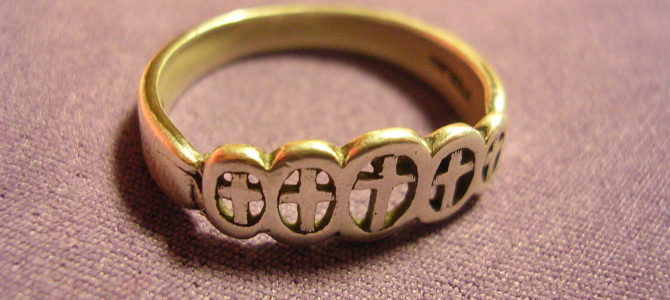
The church has tried to control sexuality because the church sees sex as its competition, says Nadia Bolz-Weber on her website promoting her new book, “Shameless.” She says, “Christians are obsessed with sex. But not in a good way. For nearly two thousand years, this obsession has often turned destructive—inflicting pain, suffering, and guilt on countless people of all persuasions and backgrounds.”
Bolz-Weber wants to bring about a “sexual reformation.” Her book particularly takes aim at the phenomena of guilt and shame that she says are so prevalent in religion.
To promote this new book, Bolz-Weber has hit upon a unique marketing strategy. She put out a call on Twitter for women to “mail in their purity rings for a massive art project.” Purity rings are rings unmarried Christians wear as a pledge to abstain from sex until they are married. Bolz-Weber is collecting the rings so they can be melted down and crafted into the shape of a vagina.
This marketing strategy is ironically similar to an event recorded in the Old Testament. Moses led the Israelites, who were recently escaped from Egypt, to Mount Sinai, where they saw God descend upon the mountain in a cloud of smoke and thunder. Moses went up to the top of the mountain, where he received from God the word of his testimony.
Moses was delayed in his return. The people grew restless and came to Moses’ brother Aaron and told him to craft a god they could worship. So Aaron collected their gold rings and crafted them into a golden calf. In the Bible, as Aaron was looking to deflect responsibility for his idolatry, he said that he “cast (their gold rings) into the fire and out came the calf” (Exodus 32:24). “Cast those purity rings into the fire,” says Bolz-Weber on her website. In exchange, participants will receive a “certificate of impurity.”
It is true that many women have come out of the evangelical Christian community with a profound sense of shame. The women who have responded to Bolz-Weber’s tweet view themselves as survivors of a theology that singled them out and damaged their sense of self-worth. Bolz-Weber is seeking to undo that damage.
In a Huffington Post interview, Bolz-Weber attempts to explain what she believes is a difference between holiness and purity: “The difference between purity and holiness is that purity is always about separation ― separating ourselves from people who are less religious, separating ourselves from our sexual natures, from our desires. But holiness is always about connection ― to God, to ourselves, to our nature.”
We can’t get around the fact that the Bible does talk about purity. The Greek words behind the translated text have to do with ritual cleanness that prepares us for interaction with God wherein we receive his holiness. He gives holiness; we borrow it. But we don’t make ourselves pure. That’s his work. We simply follow God’s commands that show his will for us so that we do not pollute the holiness that he has given. Thus, God says, “You shall not commit adultery.”
It appears that Bolz-Weber is borrowing her understanding of purity from the Christians she is condemning. Indeed, within that atmosphere there is often a fruitless attempt to purify the community by expelling those identified as sinners. Often a few sins, particularly of a sexual nature, are singled out as more terrible than others. The sinners must either become “pure” or their place in the community is undermined.
However, the same purity culture persists also among those with a more progressive sexual theology. The new sexual purity is acceptance and celebration of libertine sexual standards. Similarly, sinners who do not share this ideology also must repent or they can no longer be part of the community.
Bolz-Weber’s intention is to address the very real problem of shame that has come about because purity culture judges and condemns people according to a specific moral standard. Bolz-Weber maintains the purity culture but flips the identification of the pure and the impure. She redefines sin and reassigns shame. To be “shameless” is essentially to be self-righteous.
There is a better way. The issue at hand with either of these purity cultures has to do with that nagging question of where the individual stands with God. Am I right with God or is God angry with me? Both try to answer that question by defining sin in a way that gives them a standard they can achieve, like a child setting the finish line of a foot race close to where he is already standing.
The Bible, however, points us outside ourselves to find God’s approval. Hebrews 10 says, “Since we have confidence to enter the holy places by the blood of Jesus, by the new and living way that he opened for us through the curtain, that is, through his flesh, and since we have a great priest over the house of God, let us draw near with a true heart in full assurance of faith, with our hearts sprinkled clean from an evil conscience and our bodies washed with pure water. Let us hold fast the confession of our hope without wavering, for he who promised is faithful” (Heb 10:19-23 ESV).
In other words, since Jesus died for all sins and all sinners, he “sprinkled our hearts clean from an evil conscience.” He has washed us. He has purified us by the blood that he shed for us on the cross.
We don’t find purity by closely defining sin and then pointing fingers at others. We find purity in Jesus. We don’t find a cover for our shame in our own pledge to live up to a standard. Neither do we find a cure for our shame in our own self-esteem. Instead we find freedom and light and joy in the gospel, where God gives his righteousness.









